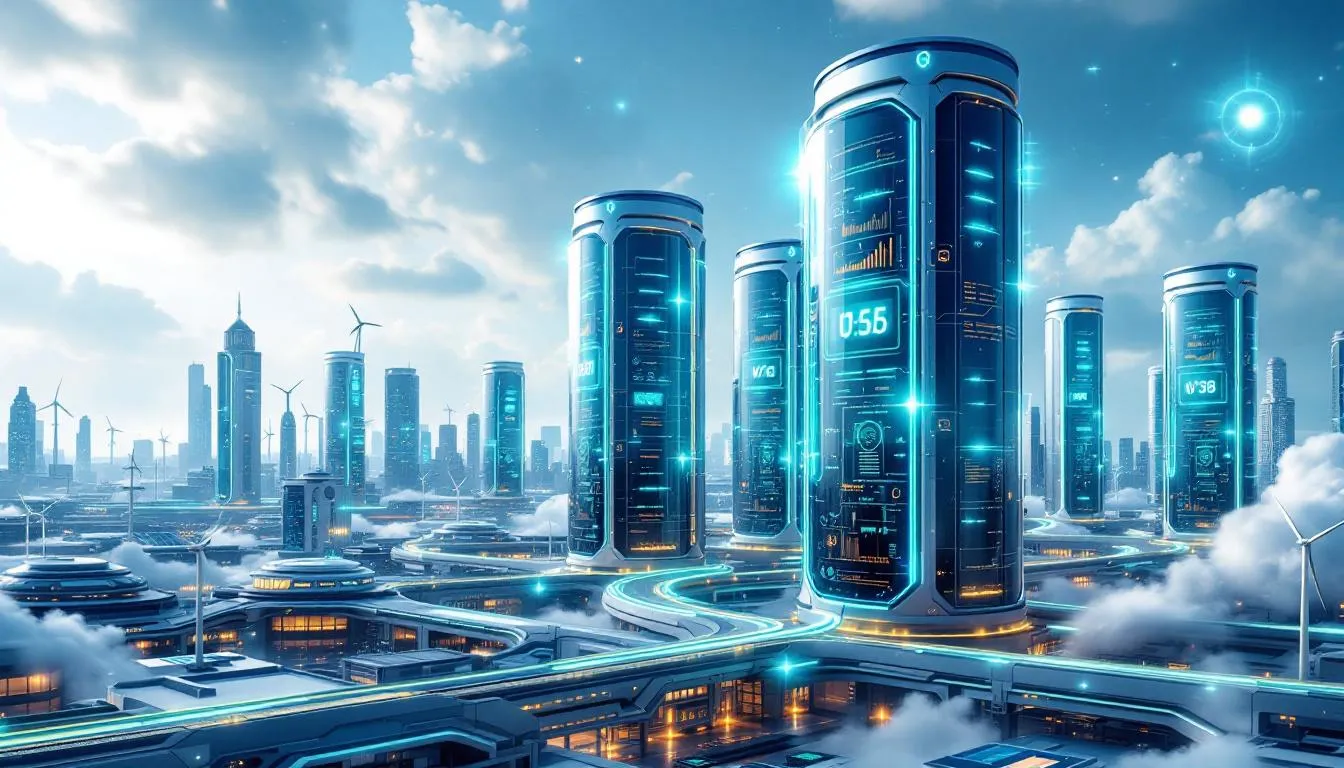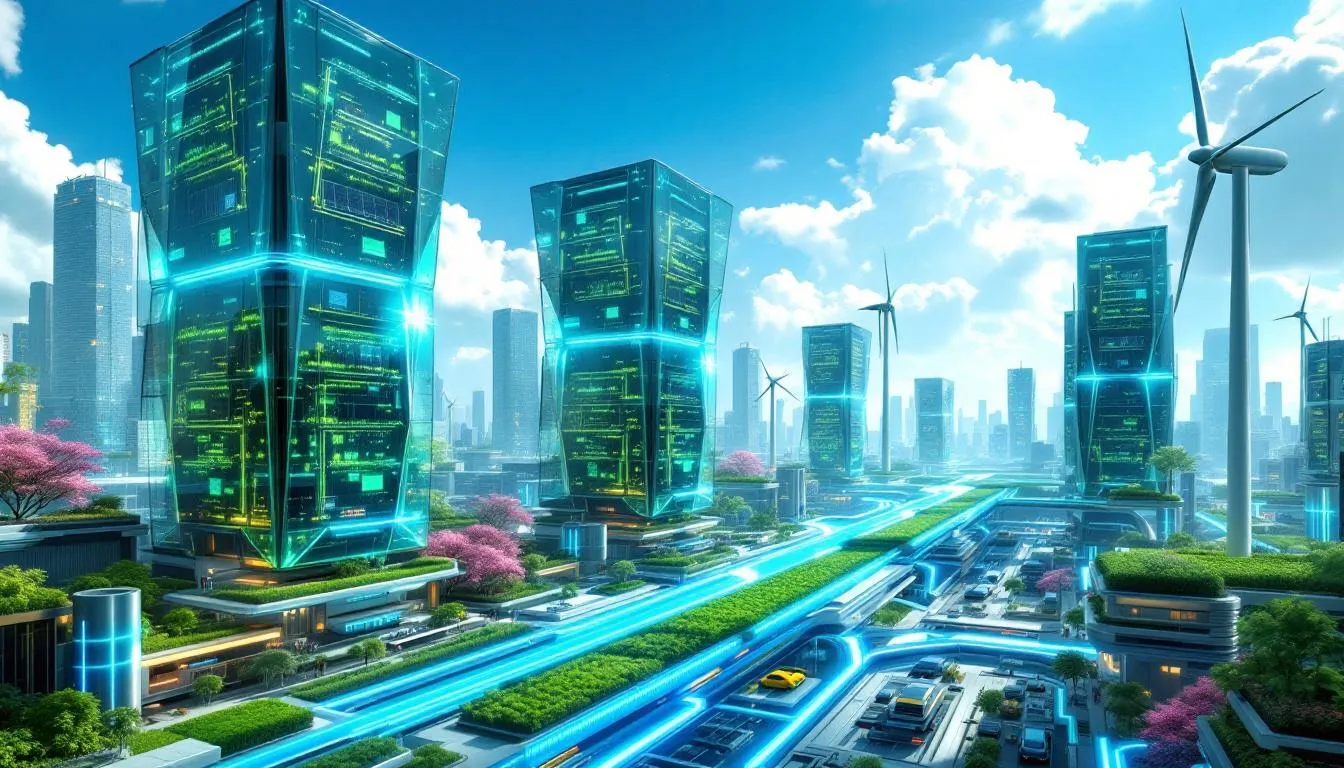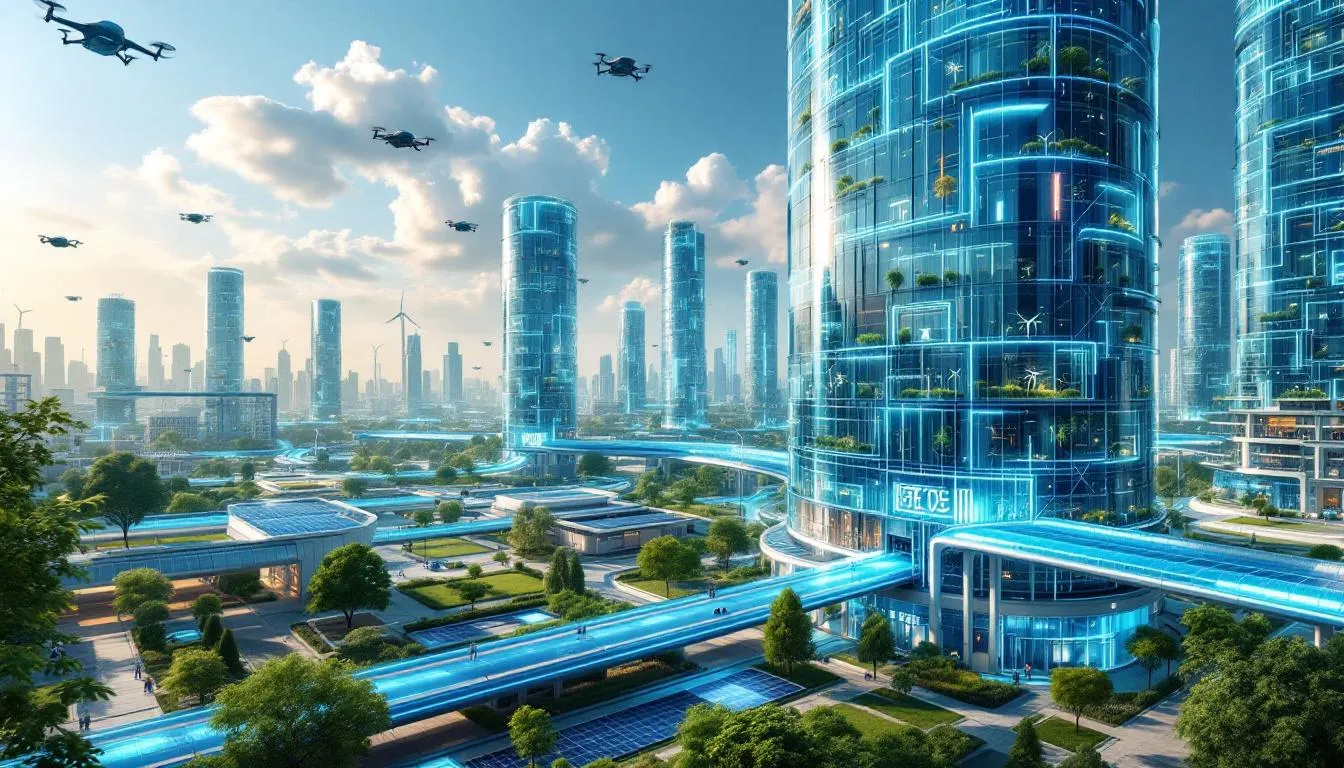
Data centers are evolving to meet growing power demands and the rise of AI. The future of data centers includes innovations in energy use, cooling, and regional development. This article explores these changes and their impacts.
Key Takeaways
- Data center energy demand is projected to rise significantly, largely due to AI workloads, necessitating substantial infrastructure investments and innovations in energy capacity.
- Developers are increasingly shifting focus to emerging markets with better energy conditions, aiming to maximize efficiency and invest in sustainable data center locations.
- The adoption of renewable energy, advanced cooling technologies, and nuclear power are pivotal trends aimed at enhancing sustainability and efficiency in data center operations.
The Surge in Data Center Power Demand
The rapid increase in data center power demand underscores the transformative impact of the ai boom and high-performance computing in ai focused data centers. These technologies need substantial infrastructure and power resources, challenging data center operators to balance large-scale computing demand with profitability and a smaller carbon footprint. Additionally, artificial intelligence data centers require careful planning to meet these demands effectively.
Energy demands for data centers are projected to rise significantly. By 2030, AI workloads are expected to account for 70% of total data center demand, pushing energy consumption to new heights. This increase could double global data center energy usage in the next five years, straining existing power grids.
Aging energy infrastructure and interconnection backlogs exacerbate power supply issues. Developers often wait three to five years to connect to the grid, further straining it and underscoring the need for significant investment in transmission capacity.
However, this rising energy demand also presents a significant investment opportunity. The data economy’s unprecedented growth and rapid growth are expected to drive the largest five-year expansion of energy costs capacity in history, offering new avenues for energy providers and data center developers to innovate and meet future demand, leading to significant growth in global power demand and a demand surge.
Regional Shifts in Data Center Development
As the data center market expands, developers are increasingly looking towards emerging and secondary markets. These regions offer lower costs and favorable energy conditions, enhancing overall investment viability and supporting the increasing demand for digital services.
Evaluating potential data center locations involves considering several critical factors like proximity to major connectivity routes, available power capacity, and minimal land ownership challenges. These criteria ensure new developments are strategically placed for maximum efficiency and minimal operational disruptions.
Regions like the Midwest are particularly attractive due to their surplus electricity. This reliable power supply is crucial for data center operations, making such regions ideal for new data center investments.
These regional shifts are reshaping the global data center landscape, creating data center opportunity for infrastructure development in new areas and diversifying the locations of data centers to better meet global demand through new data center developments and data center expansion in the digital infrastructure landscape, reflecting the evolving data center dynamics.
Embracing Renewable Energy Sources
The push towards renewable energy sources is a significant trend in the data center industry. Operators are increasingly exploring alternatives like solar and wind to tackle energy consumption challenges and boost sustainability, utilizing various energy resources.
The environmental benefits of renewable energy are substantial. Data centers that have shifted to renewable sources have reported significant emissions reductions, with some achieving up to a 50% reduction in carbon emissions. In 2021, 70% of the electricity used by some data centers came from renewables, showcasing the potential for a greener future.
Many data centers are targeting 100% renewable electricity. Facilities are forming partnerships and procuring renewable energy credits to address their climate impact and enhance sustainability efforts.
Decentralized edge computing architectures also play a role in optimizing energy use. By locating data centers near renewable energy sources, these architectures reduce strain on power grids and support more sustainable operations.
Innovations in Cooling Systems
Cooling systems are crucial for data center operations, especially with advancements in GPU technology. To accommodate these advancements, new data centers are increasingly adopting liquid cooling systems to manage the heat from AI and high-performance computing workloads.
Different cooling methods offer various benefits:
- Direct liquid cooling removes heat from servers efficiently, suitable for AI and HPC workloads.
- Immersion cooling submerges hardware in non-conductive fluids, allowing high-density deployments and effective heat management.
- Evaporative cooling uses water evaporation to absorb heat, proving effective under certain conditions.
Hybrid cooling methods maximize efficiency by integrating different technologies tailored to specific equipment needs. The use of AI in cooling systems can further optimize energy use by adapting to real-time cooling requirements, thereby reducing waste in the context of the ai revolution.
Strategic data center design, including hot/cold aisle containment, significantly enhances cooling efficiency, ensuring that data centers remain operational and energy-efficient even as power demands increase.
The Role of Nuclear Power in Future Data Centers
Nuclear power is emerging as a clean and reliable alternative for meeting the growing energy demands of data centers. The increasing power needs driven by AI and high-performance computing make nuclear energy a preferred solution for continuous and stable power supply.
One of the key advantages of nuclear power is its ability to provide continuous power, as nuclear plants can typically operate without interruption for up to 24 months. This reliability aligns with the demanding uptime requirements of data centers, which can face significant costs during downtime.
Small modular reactors (SMRs) represent a significant advancement in nuclear technology. These small modular nuclear reactors are modular and scalable, potentially offering a lower cost and more flexible solution compared to traditional nuclear reactors. Hyperscalers like Microsoft and Amazon are already developing SMRs to meet their energy needs.
The power output range of SMRs, from 1.5 to 300 megawatts, makes them suitable for various data center sizes and requirements, providing a promising solution for future energy challenges.
Overcoming Supply Chain Constraints
Supply chain constraints, primarily due to semiconductor availability and geopolitical factors, are a significant challenge for data center operators. Lead times for critical supplies have dramatically increased, with backup generators now taking years instead of months to obtain. These delays can hinder development and operational efficiency, highlighting the need for effective mitigation strategies.
To tackle these constraints, data center operators are leveraging advanced supply chain design software and scenario modeling tools. These tools enhance visibility and help prepare for potential disruptions, ensuring that data centers can continue to operate smoothly despite supply chain challenges.
Legislative initiatives like the U.S. CHIPS and Science Act aim to boost domestic semiconductor production. While the benefits of such initiatives will take time to materialize, they represent a crucial step towards building more resilient supply chains for the data center industry.
Enhancing Energy Efficiency in Data Center Operations
Enhancing energy efficiency is crucial for data centers, given their substantial power demands. Adopting liquid cooling technologies can maintain optimal server temperatures while reducing overall energy use, making it a vital component of modern data center designs.
Continuous energy monitoring systems are essential for identifying inefficiencies and tracking progress toward energy efficiency goals. These systems help optimize energy consumption and reduce waste.
Intelligent power distribution units (PDUs) enhance energy management by distributing power more efficiently and minimizing waste. Additionally, improving server utilization through techniques like virtualization can significantly lower energy consumption, contributing to overall efficiency gains.
Achieving a lower Power Usage Effectiveness (PUE) is a clear indicator of better energy efficiency in data center operations. Data centers are projected to consume around 1% of the world’s electricity, making energy optimization essential for sustainable growth.
The Impact of Quantum Computing
Quantum computing promises to revolutionize data processing capabilities in data centers. Leveraging principles like superposition and entanglement, quantum processors can perform parallel computations, dramatically improving data processing speeds and solving complex problems that classical computing struggles with.
However, the practical implementation of quantum computing in data centers requires robust quantum error correction to ensure reliability and performance. This aspect is critical for integrating quantum computing into existing data center infrastructure and realizing its full potential.
Strategic Investments in Data Center Infrastructure
Strategic investments in data center infrastructure and digital infrastructure are crucial for meeting the growing power demands and technological advancements. In 2025, data center growth is expected to lead to record levels of data center development financing, with approximately 10 gigawatts projected to begin construction and 7 gigawatts anticipated to be completed, enhancing data center capacity and data center space.
The data center sector will require an estimated $170 billion for development or permanent financing, highlighting the substantial investments needed to support infrastructure growth. These investments are driven by the need to accommodate increased computing power and data storage requirements.
High construction costs for new data centers are influenced by elevated material prices and interest rates. Despite these costs, there is strong interest from investors, although the trading volume of global data centers is expected to see only moderate growth due to high bid-ask spreads.
These strategic significant investments are essential for building resilient and efficient data center infrastructure that can support future technological advancements and growing energy demands.
The Importance of Community Engagement
Early engagement with local stakeholders is crucial for data center developers. Addressing community concerns and building supportive relationships fosters trust and acceptance, ensuring smoother project implementation.
Transparent communication about the potential impacts of data centers and involving communities in decision-making enhance trust. This approach helps communities understand the benefits and address any concerns.
Data center operators are encouraged to create shared value through strategic community investments. These investments can enhance local economic and social conditions, contributing to a positive relationship between data centers and the communities they operate in.
Long-term community investment strategies should focus on measurable outcomes rather than short-term charitable contributions. This approach ensures that the benefits of data centers are sustainable and aligned with the long-term goals of the communities.
Preparing for Future Energy Challenges
Integrating advanced technologies and smart meters has significantly improved energy monitoring and management within the power grid. These innovations enable more efficient and reliable energy distribution, critical for meeting the growing energy demands of data centers.
With grid modernization, cybersecurity has become increasingly vital. Rising threats necessitate robust security measures to protect energy infrastructure and ensure uninterrupted data center operation while considering grid capacity.
Utilities are beginning to adopt automated data analysis tools to enhance grid optimization and efficiency. Additionally, integrating quantum hardware into existing data center infrastructure presents challenges that require careful planning, resource allocation, and personnel training to ensure seamless integration and maximize the benefits of quantum computing.
The Rise of Edge Computing
Edge computing is revolutionizing the data center landscape by reducing latency and processing data closer to the source. This capability is essential for real-time applications like AI, where rapid data processing is crucial. The market for edge computing is expected to grow significantly, from $9 billion in 2020 to $445 billion by 2030. This growth is driven largely by advancements in AI and the increasing demand for low-latency computing.
Edge computing facilitates faster decision-making for AI applications by minimizing delays in data transmission. It also optimizes resources by offloading processing tasks to edge data centers, enhancing overall efficiency for digital services.
Moreover, edge data centers contribute to enhanced data privacy, as sensitive information can be processed locally, reducing the need to transmit it over the internet. This capability is particularly beneficial for industries like healthcare and manufacturing, where real-time monitoring and predictive maintenance are critical.
Summary
The future of data centers lies in their ability to innovate and adapt to growing demands while maintaining a commitment to sustainability. From addressing the surge in power demand to embracing renewable energy sources, the data center industry is making significant strides in enhancing efficiency and reducing environmental impact.
Innovations in cooling systems, the adoption of nuclear power, and strategic investments in infrastructure are all key components in building resilient and efficient data centers. Moreover, community engagement and preparation for future energy challenges ensure that data centers can operate sustainably and harmoniously within their environments.
As we move forward, the rise of edge computing and the potential of quantum computing will further revolutionize the data center landscape. These advancements will enable faster, more efficient data processing, meeting the demands of an increasingly digital world. The journey towards a sustainable and efficient future for data centers is well underway, driven by innovation and strategic foresight.





